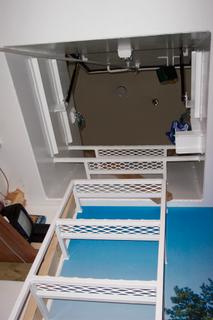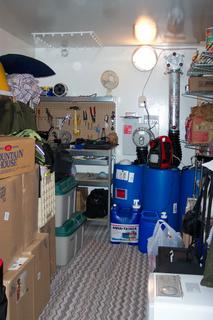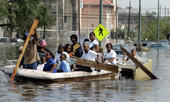 Every household SHOULD already be perfectly aware of the need to have some savings put aside for a rainy day. Sure ... to actually get it done is more challenging for some than others, so if you are not able to find the money for saving or investing beyond meeting your monthly budgetary needs (and perhaps for your extra crisis-preparedness investments), that's OK. You only do what you can do.
Every household SHOULD already be perfectly aware of the need to have some savings put aside for a rainy day. Sure ... to actually get it done is more challenging for some than others, so if you are not able to find the money for saving or investing beyond meeting your monthly budgetary needs (and perhaps for your extra crisis-preparedness investments), that's OK. You only do what you can do.But if at all possible, we should all be trying to lay up a little something to fall back on. Why? ... common sense says, for personal setbacks such as job loss, income reduction due to injury or illness, divorce, etc.
But then, there is also the possibility of broader economic disaster. That is what I will primarily outline a plan for here, though to have a fallback financial plan of any kind is going to likely be a safety-net for you in whatever actual economic crisis you might one day face.
System Failure
First, let me be clear. I am not a financial adviser. I do not sell any kinds of investments or commodities. To tell you the truth, I'm barely qualified to keep my business's financial records from becoming a Quickbooks case-study in categorized chaos.
That warning out of the way, what I CAN impart here is some standard, basic conventional wisdom that most preparedness adherents would concur would be a reasonable approach for those looking to weather a recession or even a depression. Some of it is financially related, and some goes beyond that. You'll need to determine the wisest approach for your given situation, but I offer the following points to provoke some thought toward a world gone suddenly poor.
One other caveat--there are those who would say, any practical physical preparations would be superior to monetary assets on hand in a worst-case scenario.
Indeed, in the recent Hurricane Katrina aftermath, there were news reports of at least local pockets where a barter economy quickly superseded the normal system of trade. Gasoline, cigarettes, and beer replaced cash as the most effective units of trade. So if it's one or the other, physical preparedness or financial preparedness, you might consider getting your physical stores in place first.
So the big question is--Is it feasible that our economic system in America could be dealt a serious blow in today's world, to the effect of bringing the system to its knees? And in fact, would such an event not also disable the global economy and effectively leave us to our own devices to recover?
Yes, of course it's possible. Our economic system, increasingly dependent upon electronic security and viability, global political stability, and substantive interconnectivity among international entities of all stripes and principles, is constructed as a house of cards upon shifting sands. It seems only to be a matter of WHEN sudden gusts will take down the towers of blind, misguided trust we have built.
The global price of oil is just one obvious linchpin that is obscenely vulnerable to a range of issues beyond America's real control. Major acts of terror can also bring down our markets of trade in an instant, especially if targeted to do so as we saw on September 11, four years ago (do not forget that our economy's destruction is the ultimate stated objective of the Islamic terrorists we are at war with).
Could we withstand another major natural disaster anytime soon without breaking the back of this country's economic system?
And what about the expected avian flu pandemic that by all accounts will literally shut the world down for an unknown, prolonged period of time?
Yes. Economic disaster should be on your radar screen. Consider it possible and mitigate your risks.
Begin to Offset Your Risks
1. Do not have all your financial assets tied up in one place--especially not in the stock market. Within the last five years, that lesson was brought home to this generation of investors and it should not be forgotten. Neither should you count on a home or property that is bought and paid for as being "money in the bank."
2. Speaking of which, do not keep all or even most of your money in one bank. Wherever you do have your savings, be sure your money is easily and quickly accessible in the event you see indications of a potential banking collapse. It's happened before--here, and elsewhere in the world, so don't dismiss that as being too far-fetched.
3. Consider putting some of your money in precious metals and physically holding them (safely) in your possession. Gold and silver are traditional, historical ways of protecting wealth. If currencies become moot, it is logical to assume that many will see these metals (in the form of minted, recognizable coinage) as being worthy commodities for trade of all kinds.
4. Do have some cash on hand as well for emergency uses in the event of trouble of any kind.
5. Consider having on hand quantities of other items or materials of value that would be of universal practical appeal in a system-failure scenario. Almost anything is possible to barter, but some things will of course become more coveted than others in worst-case events ... use your imagination and determine whether it would make sense for you to put some of your excess available resources into commodities of potential worth. Think of things that everyone uses and needs but that would quickly disappear if the "Just in Time" supply system grinds to a halt.
6. I have to suggest that you give some serious thought to what you would do if you somehow lost your current home. How you would lose the home is irrelevant, as there are many ways it could happen. If it does happen, you would be well-served to have thought through your options at least preliminarily and have some options to pursue.
7. Finally, be sure you have a diverse array of skillsets within your toolbox. Be willing and ready to work in fields or in jobs that you are not involved in today. There may be more of a market for people able to engage in strong physical labor than in the predominantly managerial/administrative fields wherein America currently employs its people. Certainly, "necessary" physical trade skills and knowledge will be more in demand if global trade flows are interrupted. Knowledge and abilities will be king, so the more you have to offer in terms of practical, life-sustaining capabilities, the better off you will be. Now would be the time to start embracing those types of learning opportunities.
In summary, we are talking about preparing for the possibility of a wide-scale change in the landscape of American and global lifestyles. We hope it doesn't happen, but it could. So, if you want to be prepared for a disasters--this one is a fundamental threat that needs some attention.


















